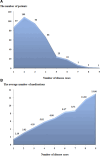Characteristics of the current situation of drug use in elderly patients with chronic diseases in Chongqing: A cross-sectional survey
- PMID: 39560587
- PMCID: PMC11576017
- DOI: 10.1097/MD.0000000000040470
Characteristics of the current situation of drug use in elderly patients with chronic diseases in Chongqing: A cross-sectional survey
Abstract
Following improved accessibility to medical services, the phenomenon of polypharmacy in elderly patients with comorbidity has been increasing globally. Polypharmacy patients are prone to drug interactions, adverse drug reactions, and even the risk of death etc. Therefore, there is an urgent need to fully understand the current status and characteristics of drug use in elderly patients with chronic diseases, focusing on polypharmacy factors to ensure that medications for elderly patients are effective and safe. To collect and analyze the characteristics of the current drug use situation in elderly patients with chronic diseases in Chongqing and further explore the influencing factors for polypharmacy, providing references for formulating more effective and safe medication regimens for elderly patients. Most elderly patients affected with chronic diseases in Chongqing were willing to go to hospitals or pharmacies to buy medicines. However, they were not familiar with their disease conditions and drug-related adverse reactions and could not be regularly followed up or monitored. The number of diseases, medications, and adverse drug reactions increased with the increasing age of elderly patients. The problem of irrational use of drugs in elderly patients with chronic diseases was relatively prominent, especially the use of traditional Chinese medicines. The medication situation in elderly patients with chronic diseases was not optimistic, and the problem of polypharmacy was relatively prominent. Further large-scale studies are needed to provide a certain reference for improving the current status of drug use in elderly patients.
Copyright © 2024 the Author(s). Published by Wolters Kluwer Health, Inc.
Conflict of interest statement
The author(s) of this work have nothing to disclose.
Figures





Similar articles
-
Exploring polypharmacy burden among elderly patients with chronic diseases in Chinese community: a cross-sectional study.BMC Geriatr. 2021 May 13;21(1):308. doi: 10.1186/s12877-021-02247-1. BMC Geriatr. 2021. PMID: 33985446 Free PMC article.
-
General practitioners' views on polypharmacy and its consequences for patient health care.BMC Fam Pract. 2013 Aug 15;14:119. doi: 10.1186/1471-2296-14-119. BMC Fam Pract. 2013. PMID: 23947640 Free PMC article.
-
Drug-related problems in institutionalized, polymedicated elderly patients: opportunities for pharmacist intervention.Int J Clin Pharm. 2015 Apr;37(2):327-34. doi: 10.1007/s11096-014-0063-2. Epub 2015 Jan 31. Int J Clin Pharm. 2015. PMID: 25637404
-
[Pharmacotherapy in the elderly: primum non nocere!].Rev Med Liege. 2014 May-Jun;69(5-6):282-6. Rev Med Liege. 2014. PMID: 25065233 Review. French.
-
[Drug-related problems in the elderly].Orv Hetil. 2012 Dec 9;153(49):1926-36. doi: 10.1556/OH.2012.29500. Orv Hetil. 2012. PMID: 23204299 Review. Hungarian.
Cited by
-
Artificial Intelligence-Assisted Clinical Decision-Making: A Perspective on Advancing Personalized Precision Medicine for Elderly Diabetes Patients.J Multidiscip Healthc. 2025 Aug 4;18:4643-4651. doi: 10.2147/JMDH.S529190. eCollection 2025. J Multidiscip Healthc. 2025. PMID: 40787142 Free PMC article.
References
-
- National Bureau of Statistics of the People’s Republic of China. China Statistical Yearbook, 2020. China Statistics Press. 2020.
-
- China Development Research Foundation. China development report, 2020: development trends and policies of China’s population aging. 2020. https://www.cdrf.org.cn/llhyjcg/5787.htm. Accessed November 6, 2024.
-
- The United Nations Department of Economic and Social Affairs. World Population Ageing 2019. 2019. http://health.people.com.cn/n1/2019/0619/c14739-31168811.html. Accessed November 6, 2024.
-
- Ornstein SM, Nietert PJ, Jenkins RG, Litvin CB. The prevalence of chronic diseases and multimorbidity in primary care practice: a PPRNet report. J Am Board Fam Med. 2013;26:518–24. - PubMed
-
- Yan W, Lu Y, Zhang R. Multimorbidity status of the elderly in China-research based on CHARLS data. Chin J Disease Control Prev. 2019;23:426–30.
MeSH terms
LinkOut - more resources
Full Text Sources

